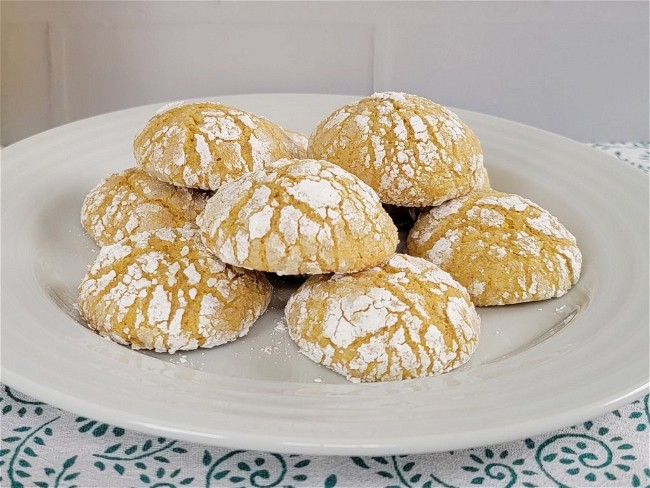Lemon Spelt Crinkle Cookies
These lemon crinkle cookies with spelt flour and sourdough starter are a delicious fiber-filled treat to brighten your day. If you have lemons to spare, try the preserved lemon recipe in the notes.
Lemon Spelt Crinkle Cookies
Rated 4.3 stars by 4 users
Category
Dessert
Servings
28
Prep Time
30 minutes
Cook Time
14 minutes
Peak harvest of lemons is in the fall and winter months in the northern hemisphere, and these bright, tart lemon crinkle cookies may be just what you need to counteract the gray chill of winter.
These lemon crinkle cookies with spelt flour and sourdough starter are a delicious fiber-filled treat to brighten your day. If you have lemons to spare, try the preserved lemon recipe in the notes.
This recipe calls for Whole Spelt flour (available from Arva Flour Mills) instead of all purpose flour for more fibre, vitamins, and minerals as well as a complementary nutty flavour.

Ingredients
-
300 - 330 grams Arva Flour Mills Whole Spelt flour, or home-milled sprouted spelt berries (2 1/3 - 2 1/2 cups flour)
-
3/4 tsp baking powder
-
1/2 tsp baking soda
-
1/2 tsp salt
-
1/4 tsp ground turmeric
- 3/4 cup granulated sugar (150 grams)
- 2 Tbsp lemon zest
- 1/2 cup unsalted butter, softened (113 grams)
- 1 egg + 1 yolk room temperature
-
1/4 cup sourdough starter (discard or ripe, doesn't matter) (80 grams)
- 1/4 - 1/3 cup lemon juice (60-80 grams)
-
2 tsp vanilla extract
-
1/4 cup granulated sugar
-
1/2 cup powdered sugar
Cookie Batter
Coating
Directions
Whisk the flour, baking powder, baking soda, salt, and turmeric in a bowl and set aside.
Combine the lemon zest and sugar in the bowl of a stand mixer or in a large bowl. Rub the zest and sugar together to release the lemon oils.
Add the softened butter to the sugar and mix on medium speed for several minutes with the paddle attachment until it is pale and fluffy. If mixing by hand, use a wood spoon or a stiff spatula to cream the butter and sugar together. Once no butter pieces are visible, continue mixing for a minute or two. To introduce more air into the mixture, this final mixing can be done with a fork, as if you're beating eggs.
One item at a time and mixing in between, add the whole egg and yolk, sourdough starter, lemon juice, and vanilla extract. Pause the mixer and scrape down the sides before mixing more.
Add the dry ingredients to the mixer and mix on low speed until just incorporated. The batter should be sticky and not so wet it falls off your spatula (see video below). If your batter is too dry, add a small amount of lemon juice. If it is too wet, add more flour.
Cover and refrigerate for 1-3 hours. Letting this acidic batter sit for longer will reduce the effectiveness of the baking soda and powder, but it's important to fully chill the batter. If pressed for time, use the freezer.
When ready to bake the cookies, preheat the oven to 350°F and line a full baking sheet or two half sheets with parchment paper.
Set up two small bowls, one with granulated sugar and one with powdered sugar.
Form balls of cookie batter about 1 tablespoon in size, and coat them first in granulated sugar and then in the powdered sugar. This double coating helps the powdered sugar not melt into the cookie. I suggest rolling all the balls before the coating step so that extra sugar doesn't transfer off your fingers to subsequent balls. Place on a baking sheet with 1-2 inches between. If you are baking in two stages, while the first sheet bakes, refrigerate the second baking sheet or pop the bowl of batter into the freezer. This is to ensure the batter stays chilled.
Bake for 13-15 minutes or until the bottom of a cookie is lightly browned.
Cool on a rack and store in a closed container.
Recipe Note
Recipe for Preserved Whole Lemons
Most fermented lemon recipes have you partially quarter the lemons and pack them with some of the salt. This recipe, adapted from Melissa K Norris, ferments the lemons whole, resulting in a less salty lemon that is useful for more dishes.
Wash the lemons thoroughly with warm water and dry them.Assess your jar size and number of lemons that will fit. You want to be able to pack them in tightly but with room on top for the brine to completely cover them.Using salt with no iodine and no anti-caking agents, make a 4% brine. For example, for 474 grams water (2 cups), you will need 19 grams of salt. 474 x 0.04 = 18.96 This is a heaping tablespoon of salt per 2 cups water. Pour the brine over the lemons so they are completely submerged. Use a glass weight if any lemons float to the top. Put a lid on the jar that allows air to escape but not enter. Let ferment at room temperature for 3-5 days (kitchen temp dependent), then transfer to the refrigerator.
